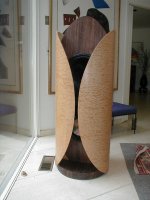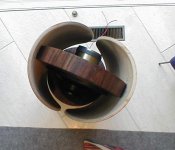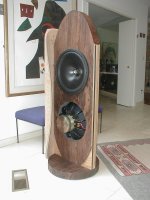planet10 said:
Good idea... i used a similar concept for the diffraction killer pictured.
I like an odd number of points and on the felt-star i also beveled the edges of the cutout.
dave
Nice Work ! But wait a minute sure reminds me a lot of the Duntech and the Dunlavy speakers
😉
About foldable baffles:
Doesn't it occur to anybody if the baffles has big wings folded back it is actually a waveguide for the midbass range, distorting the polar eight pattern of the baffle, reducing the efficiency to the front and increasing to the back in the ~80-300Hz range.
So instead of folding back, folding forward is a better and more efficient soution than increasing the baffle size. This combined with the possibility of moving the folded forward baffle closer to room corners can give just enooug gain to have a relatively flat bass down to the 40s even with a weaker driver. ( Been there, done that...)
Doesn't it occur to anybody if the baffles has big wings folded back it is actually a waveguide for the midbass range, distorting the polar eight pattern of the baffle, reducing the efficiency to the front and increasing to the back in the ~80-300Hz range.
So instead of folding back, folding forward is a better and more efficient soution than increasing the baffle size. This combined with the possibility of moving the folded forward baffle closer to room corners can give just enooug gain to have a relatively flat bass down to the 40s even with a weaker driver. ( Been there, done that...)
It is tempting to have the baffle touch the sidewalls as well as the floor. Then you have a huge baffle. But also probably some resonance behind, and maybe wierd diffraction off the walls.
The currewnt Home Theater Magnaplaners attach to the wall though, so clearly it could possibly work out. Best are probably flat baffles.p
The currewnt Home Theater Magnaplaners attach to the wall though, so clearly it could possibly work out. Best are probably flat baffles.p
about foldable baffles
@ fcserei:
Linkwitz and Backman say that the speaker basket forms a kind of Helmholz resonator, affecting the backward radiation of the speaker. So in reality the polar eight pattern is already distorted in a flat baffle.
IMHO when you fold the baffle you don´t change efficiency - you just change directivity. And this chance should not regard bass below 100 Hz. Could you give us a thumbsketch of the geometry that gave you "just enough gain to have a relatively flat bass down to the 40s"?
By the way: I have tried to elongate the baffle by moving it close to a wall, but got no discernible bass boost. Maybe I already had used the maximum baffle width for the driver.
@ fcserei:
Linkwitz and Backman say that the speaker basket forms a kind of Helmholz resonator, affecting the backward radiation of the speaker. So in reality the polar eight pattern is already distorted in a flat baffle.
IMHO when you fold the baffle you don´t change efficiency - you just change directivity. And this chance should not regard bass below 100 Hz. Could you give us a thumbsketch of the geometry that gave you "just enough gain to have a relatively flat bass down to the 40s"?
By the way: I have tried to elongate the baffle by moving it close to a wall, but got no discernible bass boost. Maybe I already had used the maximum baffle width for the driver.
The basket Helmolz resonance occurs above the range I mentioned.
You're right, it won't change efficiency, just the coupling will be different to the front than the rear, so bigger portion of the radiated energy goes to the front than to the back.
I've played quite a lot with Diatones, Goodmans Axioms on baffles, but surprisingly electrostatic panes has the greatest effect. Two 30" wing folded forward to 60 degrees gave ~6dB gain below 250Hz compared to flat baffles.
You're right, it won't change efficiency, just the coupling will be different to the front than the rear, so bigger portion of the radiated energy goes to the front than to the back.
I've played quite a lot with Diatones, Goodmans Axioms on baffles, but surprisingly electrostatic panes has the greatest effect. Two 30" wing folded forward to 60 degrees gave ~6dB gain below 250Hz compared to flat baffles.
Hello Kuei Yang Wang,
i relate to posting #22
http://www.diyaudio.com/forums/showthread.php?postid=232164#post232164
Using this speaker http://www.spectrumaudio.de/breit/beyma8AGN.html
with Qts 1.15 and resonace frequency 105Hz, whats not far from your given 100Hz / 1.0
would an open baffle of 27cm wide * 44cm high also be optimum or should i modify this measures?
whats the rule to determinate the optimal baffle size for a given driver like this?
Thank You, Till
i relate to posting #22
http://www.diyaudio.com/forums/showthread.php?postid=232164#post232164
.... If the driver has a Qt of 0.5 the output on an INFINITE baffle will be 6db down at the drivers resonance. Using a Driver with a Qt of 0.7 the output will be down 3db at resonance. Using a Qt of > 0.7 will result in a certain peaking of the driver output around Resonance, which can be used to offset the reduced output from open baffle mounting. .... The second thing is that Olsons formulas for baffle width are inaccurate. For a simple "ballpark" idea, a plan Baffle with an assymetrically placed driver and a total circumference (all edges of the baffle measured) of 140cm (eg 27cm wide and 44cm high) will provide a +3db peak centered around 400Hz and will have
a -3db point of around 100Hz for the BAFFLE ONLY. The frequency scales with size. ....SO if we had a driver with an Fs of 100Hz and a Qt around 1.0 (say a classic German Saba "Greencone" 8" Radio Full range Speaker) on the above baffle the result would be a speaker with a response flat to around 100Hz and then rapidly rolling with a slope a little steeper than 3rd order.
....
Using this speaker http://www.spectrumaudio.de/breit/beyma8AGN.html
with Qts 1.15 and resonace frequency 105Hz, whats not far from your given 100Hz / 1.0
would an open baffle of 27cm wide * 44cm high also be optimum or should i modify this measures?
whats the rule to determinate the optimal baffle size for a given driver like this?
Thank You, Till
Well, I have (re)joined the OB club using my Goodmans 201s and piezo tweeters.
This project is currently a test bed to try out a few ideas and has so far cost me just 7UKP for materials. The 4 x 2 feet baffles are 12mm chipboard with a 25mm layer of polystyrene on the front. The frames are made from timer hauled off my friend's firewood pile!
I am surprised as there seems to be virtually no loss of bass. The soundstage is definitely deeper and overall, I prefer the sound to the ported cabinets that the 201's inhabited previously.
Plans are to build a baffle from wood and glass but I may temporarily cover that polystyrene sheet with some nice material to blend these panels into the room decor.
This project is currently a test bed to try out a few ideas and has so far cost me just 7UKP for materials. The 4 x 2 feet baffles are 12mm chipboard with a 25mm layer of polystyrene on the front. The frames are made from timer hauled off my friend's firewood pile!
An externally hosted image should be here but it was not working when we last tested it.
I am surprised as there seems to be virtually no loss of bass. The soundstage is definitely deeper and overall, I prefer the sound to the ported cabinets that the 201's inhabited previously.
An externally hosted image should be here but it was not working when we last tested it.
Plans are to build a baffle from wood and glass but I may temporarily cover that polystyrene sheet with some nice material to blend these panels into the room decor.
Has anyone tried Visaton B200 8" fullrange driver yet? It looks like open baffle material to me and the price is right imho. 🙂
/Erik
/Erik
Has anyone tried Visaton B200 8" fullrange driver yet?
The people at Visaton combined the B200 with a BGS40 woofer:
http://www.visaton.de/vb/showthread.php?threadid=5574
The baffle dimensions are 122 cm height and 50 cm width. Wings 35 cm at the bottom and ca. 15 cm at the top. Fullrange speaker 80-90 cm from the floor.
Rudolf
open baffles
Hello,
I have been contemplating building a pair of Open Baffles, on and off, for a long time. I am not sure that my room is suitable, as I may not be able to get sufficient space behind them, but I intend to try! I am a great fan of Transmission Lines, having built several, mainly 2way, for my self and friends. They work superbly in my room, I prefer low Qts drivers. A friend recently used a Scanspeak 8554 ( Qts 0.22 ) in a TQWT and the results are excellent.
However my interest in Dipoles has been revived, as another friend has ask me to help him up grade his mid range units on his large, 3way, Tline . I have always found the latter rather coloured, due to, I believe, the very small rear enclosure ( Peerless KO40 ). You can always hear the transition between the “open “ bottom end and the compressed mid. Two articles in the greatly missed “Speaker Builder” confirmed my views eventually, 7&8 - 2000, by Jim Moriyasu. Very enlightening.
As mentioned, I do not have the room for a pair superb looking transparent plastic flat baffles, so I will have to use rear extensions to achieve the necessary width. It is these panels that always bothered me.
Obviously there is as much air being moved at the back as at the front, though the driver chassis/magnet system and rear cone shape modifies the pressure wave. I believe screened magnets could help in improving the aerodynamics; the new Scanspeak drivers have slimmer chassis frames for this purpose.
To maintain the basic baffle shape and not have angled sides, etc, which might not be aesthetically pleasing, I have thought of using triangular sections, on all the panels, from the driver cut-outs to the extension edges. This should again help the aerodynamics by avoiding the sharp termination at the corners. These sections would also increase the rigidity on this vital area around the driver. As shown in the above articles and else ware, that chamfering the back of the driver cut-outs is important in reducing turbulence and distortion. The slight horn loading (?) might beneficial in reducing any losses caused by the rear obstructions. It seems logical to me that the effort put in to make sure the front baffle has clean, smooth contours, rounded edges, etc, we should try to ensure the same is done on the back, particularly with dipoles and probably with lines.
I would be grateful if you dipole experts out there, could offer your advice and comments on the above.
Cheers
Roy
Hello,
I have been contemplating building a pair of Open Baffles, on and off, for a long time. I am not sure that my room is suitable, as I may not be able to get sufficient space behind them, but I intend to try! I am a great fan of Transmission Lines, having built several, mainly 2way, for my self and friends. They work superbly in my room, I prefer low Qts drivers. A friend recently used a Scanspeak 8554 ( Qts 0.22 ) in a TQWT and the results are excellent.
However my interest in Dipoles has been revived, as another friend has ask me to help him up grade his mid range units on his large, 3way, Tline . I have always found the latter rather coloured, due to, I believe, the very small rear enclosure ( Peerless KO40 ). You can always hear the transition between the “open “ bottom end and the compressed mid. Two articles in the greatly missed “Speaker Builder” confirmed my views eventually, 7&8 - 2000, by Jim Moriyasu. Very enlightening.
As mentioned, I do not have the room for a pair superb looking transparent plastic flat baffles, so I will have to use rear extensions to achieve the necessary width. It is these panels that always bothered me.
Obviously there is as much air being moved at the back as at the front, though the driver chassis/magnet system and rear cone shape modifies the pressure wave. I believe screened magnets could help in improving the aerodynamics; the new Scanspeak drivers have slimmer chassis frames for this purpose.
To maintain the basic baffle shape and not have angled sides, etc, which might not be aesthetically pleasing, I have thought of using triangular sections, on all the panels, from the driver cut-outs to the extension edges. This should again help the aerodynamics by avoiding the sharp termination at the corners. These sections would also increase the rigidity on this vital area around the driver. As shown in the above articles and else ware, that chamfering the back of the driver cut-outs is important in reducing turbulence and distortion. The slight horn loading (?) might beneficial in reducing any losses caused by the rear obstructions. It seems logical to me that the effort put in to make sure the front baffle has clean, smooth contours, rounded edges, etc, we should try to ensure the same is done on the back, particularly with dipoles and probably with lines.
I would be grateful if you dipole experts out there, could offer your advice and comments on the above.
Cheers
Roy
Rudolf said:
The people at Visaton combined the B200 with a BGS40 woofer:
http://www.visaton.de/vb/showthread.php?threadid=5574
The baffle dimensions are 122 cm height and 50 cm width. Wings 35 cm at the bottom and ca. 15 cm at the top. Fullrange speaker 80-90 cm from the floor.
Rudolf
Thanks for the info!
Anyone who have listened to it or know anyone who have listened to it?
/Erik
Re: More....
Dear KYW,
And yes ... lovely speakers. 🙂
Tarun
Dear KYW,
How would this FR driver compare with, say, a JX92S? I was trying to understand what the extra money gets one. I had similar questions about the Phy drivers some others are using on OB designs. If I recall correctly, some of these Phy drivers are ten times as expensive as the Jordans.Kuei Yang Wang said:... the Speakers use a pair of 12" 'Wideband' Drivers custom made by Eminence for Bastanis Audio and further modified by Bastanis Audio...
And yes ... lovely speakers. 🙂
Tarun
I have been contemplating building a pair of Open Baffles, on and off, for a long time. I am not sure that my room is suitable, as I may not be able to get sufficient space behind them
Roy, I'm experimenting with open baffles and have mine working well just two feet from the rear wall. My room is 13 feet by 13 feet.
Thorsten also seems to have his close to a wall so I shouldn't let that aspect put you off trying them.
NEW OB Design
I finally finished my Dipole Subwoofer. It is modified H-Frame design with a massive dampened baffle and curved, eliptical sides.
Bass is fast and detailed. The shape provides the equivalent of a 2+ meter baffle width, so EQ is minimal. Karlson-like slots provide quasi-horn loading front and rear.
The design is symetrical, but the continuous curves and dual driver centers smooths out the response nicely.
I finally finished my Dipole Subwoofer. It is modified H-Frame design with a massive dampened baffle and curved, eliptical sides.
Bass is fast and detailed. The shape provides the equivalent of a 2+ meter baffle width, so EQ is minimal. Karlson-like slots provide quasi-horn loading front and rear.
The design is symetrical, but the continuous curves and dual driver centers smooths out the response nicely.
Attachments
Erik, what Xover compensation used for woofer cavity resonance
Folding a dipole baffle will create resonance cavities. A curved wing would spread out the resonance energy, but might complicate the compensation.
What measurements have you made on your dipole woofer, and what compensations have you added to your crossover? Does the tapered-pipe loading should show up in the measurement?
Do you crossover to the woofer below the cavity resonance, which seems about 500-600 Hz.
Oh Yeah....COOL LOOKING DESIGN
Folding a dipole baffle will create resonance cavities. A curved wing would spread out the resonance energy, but might complicate the compensation.
What measurements have you made on your dipole woofer, and what compensations have you added to your crossover? Does the tapered-pipe loading should show up in the measurement?
Do you crossover to the woofer below the cavity resonance, which seems about 500-600 Hz.
Oh Yeah....COOL LOOKING DESIGN
You went for the budget versions then Erik! 😉
Only joking, they look awesome. Do you use one or two of those?
Only joking, they look awesome. Do you use one or two of those?
- Status
- Not open for further replies.
- Home
- Loudspeakers
- Multi-Way
- Are you (open) baffled yet?


